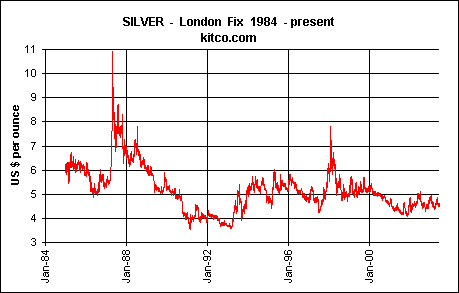Silver
Silver is the whitest of the precious metals and the most lustrous. It reflects 95 percent of the light that hits it, compared with 92 percent for gold. Next to gold, silver is the most malleable metal — it can be formed into sheets (or leaves) .00025 millimeter thick. It is second only to gold as a ductile metal — a gram of silver can be drawn out into a wire a mile long.
Silver in its pure form is almost never used in jewelry because it is too soft. It also has a tendency to tarnish.
The addition of a very small amount of copper increases the durability of silver. British silversmiths discovered that an alloy of 925 parts silver and 75 parts copper was ideal, hence the term "sterling standard." Items stamped "sterling" meet this purity standard, as set forth in the National Gold and Silver Marking Act. Sterling silver is also called silver, sterling, or solid silver.
Silver Prices
The following chart (from kitco.com) illustrates the volatility of silver prices from 1984 to 2004.

For current prices of silver, visit this page on kitco.com. And, for more information, explore the Kitco Web site for data on the prices of precious metals. You can build your own charts using time-frames you select.
While the cost of materials greatly affects the price of jewelry, workmanship is also a factor.
The bottom line is that you should buy a piece of jewelry because you love it, not as an investment!
